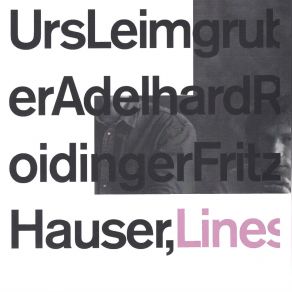Lines
Download links and information about Lines by Urs Leimgruber, Fritz Hauser, Adelhard Roidinger. This album was released in 1990 and it belongs to Jazz, Avant Garde Jazz, Classical genres. It contains 7 tracks with total duration of 01:05:49 minutes.

|
|
|---|---|
| Artist: | Urs Leimgruber, Fritz Hauser, Adelhard Roidinger |
| Release date: | 1990 |
| Genre: | Jazz, Avant Garde Jazz, Classical |
| Tracks: | 7 |
| Duration: | 01:05:49 |
| Buy it NOW at: | |
| Buy on iTunes $9.99 | |
Tracks
[Edit]| No. | Title | Length |
|---|---|---|
| 1. | Open | 12:42 |
| 2. | Shifted | 18:51 |
| 3. | Off | 4:26 |
| 4. | Twisted | 6:13 |
| 5. | Forgotten | 6:15 |
| 6. | Up | 6:56 |
| 7. | Red | 10:26 |
Details
[Edit]From Art Lange's outrageously pretentious liner notes, one might get the impression that this bad-assed trio was trying to re-invent the line and extend it out into the nothingness of the beyond and perhaps beyond that into non-being. I dig Lange, but his liner notes on this set are pure junk. What the word "lines" refers to in the title of this record is simple: This is for these well-known improvisers a quest in playing the line, playing in a linear — for them anyway — fashion. The seven selections on this disc, all of which have references to the linguistic construct "line," are formidably constructs in and of themselves. This is some smoking new jazz that features a depth of communication and commitment to energy as they translate in a mostly linear fashion to the transfer of emotion from musician through musical instruments through to the listener. Period. Along the way are some pretty stunning solos and sharp ensemble playing that take the "lines" of melody and make them somewhat angular though never twisting them into something they're not. For instance, check out the call and response between Leimgruber's soprano solo and Roidinger's double bass, one line answered succinctly and precisely with another. And it gets better where spatial dynamics are used to created complex harmonics and polytonal inventions. Here, melody is ever-present — the touch of "Blue Monk" and "Lonely Woman" in "Shifted" — and "shifted" into a different melodic reality, one where overtones — via the bowed bass — create a drone for melodic improvisation to create a new kind of framework where rhythm and counterpoint all become part of the whole. On "Red," which closes the album, line is played out across rhythmic sections and splays itself over the entire construction of microtonal ambience and rhythmic pulse which is subtly shaded, but constant and, yes, linear. Line is what the best of new jazz is about, taking the bull by the horns and going as deep musically as the particular abilities of the musicians involved will take them. All lines lead to this trio.